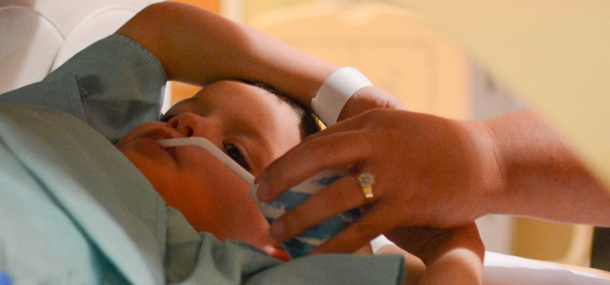

Your child’s doctor may order an upper gastrointestinal (upper GI) exam if he or she is experiencing symptoms of nausea, vomiting, abdominal or chest discomfort or difficulty swallowing. These could be a sign of a problem with your child’s gastrointestinal tract, and an upper GI can help with making a diagnosis.
Using x-ray pictures, an upper GI allows us see the esophagus, stomach and duodenum (first part of the small bowel) and to diagnose many potential causes, such as abnormal anatomy, esophageal and gastric ulcer disease, problems with motility, or anything that may obstruct the digestive tract.
In order to see what the digestive system looks like and how it functions, most children will swallow a special liquid contrast, usually barium. This barium has a slightly sweet chalky flavor, but we can add other powder flavoring to it, such as fruit punch, cherry, orange, strawberry, grape or chocolate. Children can take sips of the barium drink from a sippy cup, straw, or bottle, and ice can be added to make it cold. Some children have a gastrostomy tube (G tube) that will be used and sometimes a nasogastric (NG) tube will need to be placed to ensure that enough barium is in the stomach for accurate imaging.
X-ray pictures are taken throughout a upper GI using two different kinds of cameras: a regular x-ray camera and a fluoroscopy or live action x-ray camera. We use state-of-the-art equipment that is specially designed for imaging pediatric patients safely using the least amount of radiation exposure. Our trained technologists will measure your child’s abdomen so that the camera can be precisely programed for your child’s individual size. The radiologist will also use an imaging technique called pulsed fluoroscopy to further reduce the amount of radiation needed for the imaging. We will do everything we can to keep your child safe while getting the necessary images for the upper GI.
An Upper GI is a very interactive exam between the radiologist and your child. The radiologist will be giving instructions about drinking during the imaging and will help move your child into different positions in order to see all of the anatomy and how it’s functioning. Sometimes children become anxious during these exams or have a difficult time cooperating. You are encouraged to be at your child’s bedside to comfort and encourage him or her. Sometimes toys or other distractions like shows or the iPad can be used to help your child stay calm and cooperative during the procedure. Our radiology team will work with you and your child to accomplish these important pictures in a safe and supportive way.
At the end of the upper GI you may need to wipe off any barium from your child’s mouth and lips. Later in the day, you may also notice that your child’s stools are light or gray colored. This change in color is normal and is related to the barium given as part of the test. Drinking fluids will help clear the barium from your child’s digestive tract. The radiologist will review all the images from the upper GI and write a report, which will be sent to your doctor. This report is usually available the same day the test was performed.
Contributed by Dr. Daniel Wallihan and edited by Catherine Leopard (CCLS).